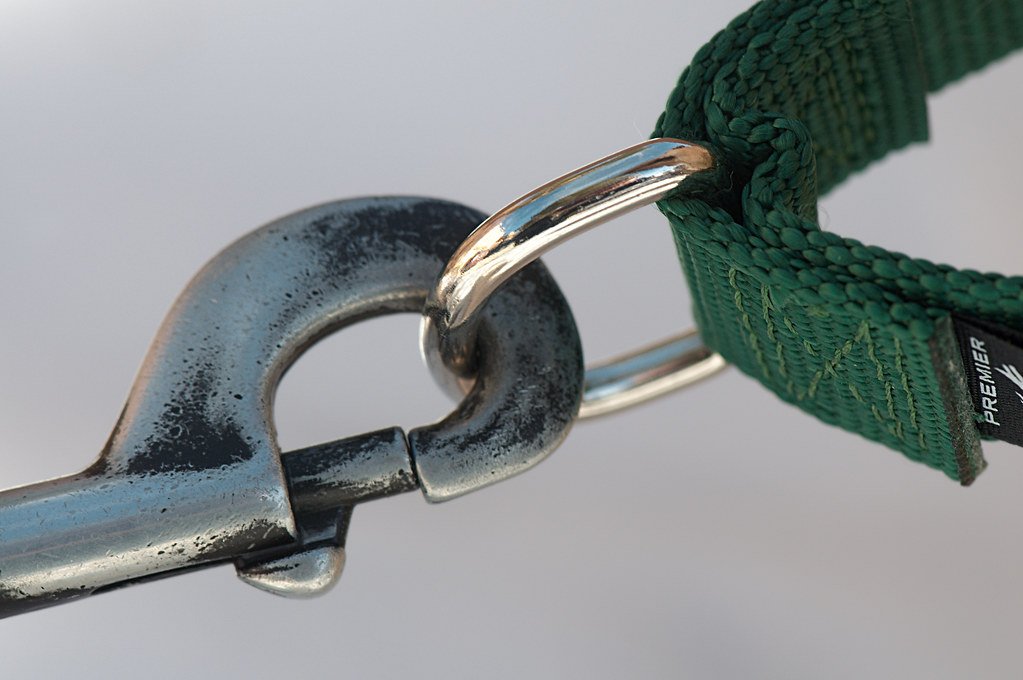You can almost hear the gentle click of paws against the pavement as your furry companion walks by your side. But what if your dog has a tendency to pull and lunge, eager to explore the world at their own frenetic pace? Enter the martingale collar – a unique tool designed to offer control and guidance while ensuring your dog’s utmost comfort. In this guide, we’ll delve into the art of using a martingale collar for dog training, unveiling its secrets and techniques that can transform your walks into enjoyable and harmonious experiences for both you and your four-legged friend. So, slip that collar high on your list of training essentials, and let’s embark on a journey of constructive reinforcement!
Table of Contents
- Understanding the Purpose of a Martingale Collar for Dog Training
- Selecting the Right Size and Fit for Maximum Effectiveness
- Step-by-Step Guide on How to Properly Use a Martingale Collar
- Common Mistakes to Avoid when Training with a Martingale Collar
- Maximizing the Benefits of Martingale Collar Training Techniques
- Q&A
- Future Outlook

Understanding the Purpose of a Martingale Collar for Dog Training
A Martingale collar is a unique tool that is widely used in dog training for a specific purpose. It is designed to provide a balance between control and comfort during walks or training sessions. Unlike traditional collars, the Martingale collar is made with a slip design that tightens when the dog pulls on the leash, but not to the point of choking or causing discomfort.
This innovative collar is especially beneficial for dogs that have a tendency to slip out of their collars and potentially run off or get into dangerous situations. The Martingale collar prevents escape by gently tightening around the dog’s neck when tension is applied, ensuring a snug fit without compromising their safety. Additionally, this collar is incredibly effective for dogs that tend to pull during walks, as it helps discourage this behavior without causing harm.
It is important to note that the Martingale collar works in conjunction with positive reinforcement methods, encouraging dogs to respond and learn commands through rewards and praise. By using this collar in dog training, pet owners and trainers can establish clear boundaries and promote better control while keeping their furry friends comfortable and safe.

Selecting the Right Size and Fit for Maximum Effectiveness
When it comes to choosing the right size and fit, it’s important to consider the impact it can have on the effectiveness of your decision. Whether it’s a pair of jeans or a piece of equipment, selecting the perfect size and fit can make all the difference.
Here are some factors to keep in mind:
- Comfort: The size and fit of an item should always prioritize your comfort. Whether it’s clothing, shoes, or even furniture, ensure that you feel at ease while using or wearing it. This will not only enhance your experience but also maximize the effectiveness of the product.
- Functionality: Consider the intended purpose of the item. Make sure the size and fit align with the functionality you require. For instance, if you’re purchasing a backpack for hiking, it’s essential to pick one that is the right size and comfortably fits your gear.
- Proportions: Pay attention to how the item complements your body’s proportions. Choosing the right size and fit can highlight your best assets and flatter your figure. A well-proportioned clothing item or accessory can make you feel confident and maximize the overall impact.
Remember, taking a little extra time to ensure the right size and fit can have a significant impact on your satisfaction and the effectiveness of the item you choose. So, go ahead, use these tips as your guide, and make the most out of your selection!

Step-by-Step Guide on How to Properly Use a Martingale Collar
When it comes to using a martingale collar, it’s essential to understand the correct way to do so. Here’s a step-by-step guide to help you navigate the process:
Step 1: Begin by adjusting the martingale collar to ensure a proper fit. The collar should be snug around your dog’s neck without being too tight. You should be able to comfortably fit two fingers between the collar and your dog’s skin.
Step 2: Slide the collar over your dog’s head, positioning the metal rings at the back of the neck. The D-ring should be on top, and the smaller ring should be below it.
Step 3: Attach the dog’s leash to the D-ring and adjust the collar, so it rests high on the neck, just behind the ears. This placement allows for maximum control without causing discomfort to your furry friend.
Step 4: When walking your dog, avoid pulling too forcefully on the leash. A martingale collar is designed to gently tighten if your dog pulls excessively, creating a slight pressure sensation that encourages them to stop pulling. Remember, it should never choke or harm your dog.
Step 5: Once your walk is complete, remove the martingale collar by unclipping the leash and sliding it off your dog’s head. Store it safely until its next use.
By following these simple steps, you can ensure that your dog remains comfortable, safe, and well-behaved while using a martingale collar.
Common Mistakes to Avoid when Training with a Martingale Collar
Training a dog with a martingale collar can be an effective way to establish control and teach obedience, but it’s important to avoid certain common mistakes that could hinder progress. By avoiding these pitfalls, you can ensure a positive and successful training experience for both you and your furry companion.
Not Properly Fitting the Collar: One of the most crucial mistakes to avoid is not fitting the martingale collar correctly. It’s important to ensure that the collar is snug enough to prevent your dog from slipping out of it, but not so tight that it becomes uncomfortable or restricts their breathing. Take the time to adjust the collar to the right fit to avoid any potential harm or discomfort.
Using Excessive Force: Martingale collars are designed to be used with a gentle and controlled approach. However, one common mistake is applying excessive force, either by pulling too hard on the leash or using sudden jerks. This can create a negative association with the collar and lead to anxiety or fear in your dog. Remember, the goal is to train and guide your dog, not to cause them discomfort or distress.
- Not Consistently Reinforcing Commands: Consistency is key when training with a martingale collar. Failing to reinforce commands consistently can confuse your dog and impede their progress. Set clear expectations, be patient, and consistently reward and reinforce desired behaviors.
- Not Seeking Professional Help if Needed: If you’re struggling with training or experiencing difficulty in achieving desired results using a martingale collar, don’t hesitate to seek professional help from a qualified dog trainer or behaviorist. They can assess the situation, provide expert guidance, and address any specific issues you may be facing.
By avoiding these common mistakes and following proper techniques, you can make the most of your training sessions with a martingale collar, building a strong bond with your dog and setting them up for success.
Maximizing the Benefits of Martingale Collar Training Techniques
Martingale collars are a popular training tool for dogs of all sizes and breeds. They offer a unique design that provides gentle control and prevents dogs from slipping out of their collars. To ensure the most effective training experience, here are some tips on :
- Consistency is key: When using a martingale collar, consistency is crucial. Make sure to use the collar every time you walk or train your dog, as this will reinforce your expectations and boundaries.
- Proper fit: It is essential to ensure that your dog’s martingale collar is properly adjusted. The collar should fit snugly but not tight around the dog’s neck. This way, you can maintain control without causing discomfort or injury.
- Positive reinforcement: Implementing positive reinforcement techniques alongside the martingale collar can enhance your dog’s learning experience. Reward your dog with treats, praise, or playtime when they exhibit desired behaviors, encouraging them to continue making positive choices.
By following these guidelines, you can make the most out of your martingale collar training techniques. Remember, it’s essential to be patient and consistent with your dog’s training. With time and dedication, you’ll build a stronger bond while teaching your furry friend important commands and improving their overall behavior.
Q&A
What is a Martingale collar?
A Martingale collar is a type of dog collar that is designed to provide gentle control and prevent dogs from slipping out of their collars. It consists of a main collar loop and an additional loop that tightens when the dog pulls, preventing escape without choking or hurting the dog.
How can a Martingale collar be used for dog training?
A Martingale collar can be a useful tool for dog training, as it provides control and prevents dogs from pulling excessively. It can be used to teach loose leash walking and discourage pulling behavior by giving a gentle reminder to the dog when they start pulling.
Is it safe to use a Martingale collar on all dogs?
Martingale collars are generally safe for most dogs when used properly. However, it is important to ensure that the collar is fitted correctly and not too tight to avoid discomfort or injury. Always monitor your dog when using any type of collar and consult a professional if you have any concerns.
How do I properly fit a Martingale collar on my dog?
To fit a Martingale collar, adjust the main collar loop so that it can comfortably fit around your dog’s neck, ensuring it is not too tight or too loose. The additional loop should be adjusted so that when it is pulled, it snugly tightens without choking or hurting the dog. Always check the fit regularly, especially as your dog grows.
Can I leave a Martingale collar on my dog unsupervised?
It is generally advised not to leave any type of collar on a dog when they are unsupervised, including a Martingale collar. This is to prevent any potential risks of choking or injury that may occur if the collar gets caught on something. Only use a collar when you can supervise your dog’s activity.
Are there any alternative training methods to using a Martingale collar?
Yes, there are various training methods that can be used in addition to or instead of a Martingale collar. These include positive reinforcement techniques, such as clicker training or using treats, leash training exercises, and working with a professional dog trainer to address specific behavior issues.
Can a Martingale collar be used for aggressive dogs?
A Martingale collar can be used for any dog, including those displaying aggressive behavior. However, it is important to note that a collar alone may not be sufficient to address aggression issues. It is recommended to consult with a professional dog trainer or behaviorist to develop a comprehensive training plan for aggressive dogs.
How do I clean and maintain a Martingale collar?
To clean a Martingale collar, use a mild soap or dog shampoo and gently scrub it with your hands. Rinse thoroughly and allow it to air dry before using it again. Regularly check the collar for any signs of wear or damage, and replace it if necessary to ensure your dog’s safety during training.
Future Outlook
As we bid adieu to this guide on utilizing the powerful tool that is the Martingale collar for dog training, we hope you have found it both informative and inspiring. In the world of dog training, finding methods that strike a balance between effectiveness and kindness can be a daunting task. However, the Martingale collar stands tall as a symbol of compassion and understanding.
Remember, dear reader, that training your furry companion is a journey, not a destination. It requires patience, dedication, and a true understanding of the unique bond you share with your four-legged friend. The Martingale collar serves as a gentle reminder that training is not about dominance or control, but rather about fostering a harmonious relationship built on mutual trust and respect.
As you embark on this training endeavor, trust in the Martingale collar to provide you with the support you need. Its innovative design ensures both security and comfort, allowing your dog to explore the world while gently guiding them towards positive behavior. With its adjustable loops, it becomes a versatile companion for dogs of various sizes and temperaments, making it a must-have tool in your dog training arsenal.
However, as with any training tool, proper usage is of utmost importance. Diligently follow the guidelines provided, and always prioritize your dog’s well-being above all else. Keep in mind that dog training is a deeply personal experience, and it may require adapting techniques to suit the unique needs of your canine companion.
As you and your furry friend march forward towards a better, more harmonious future, always remember the true essence of training: the unwavering bond between human and canine. With the Martingale collar as your ally, may your training sessions be filled with moments of growth, joy, and undeniable love.
So go forth, dear readers, and embrace the power of the Martingale collar in your dog training journey. Remember, it is not just a tool, but a symbol of understanding and connection. Let the collar guide you, and watch as your dog blossoms into the obedient and confident companion you’ve always dreamed of.
As an affiliate, my content may feature links to products I personally use and recommend. By taking action, like subscribing or making a purchase, you’ll be supporting my work and fueling my taco cravings at the same time. Win-win, right?
Want to read more? Check out our Affiliate Disclosure page.